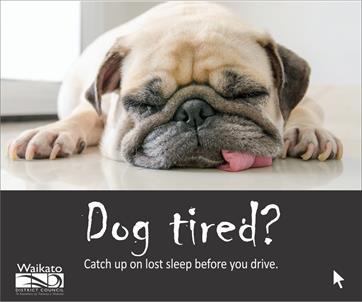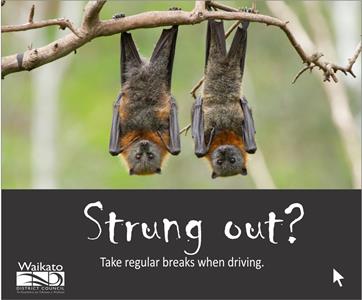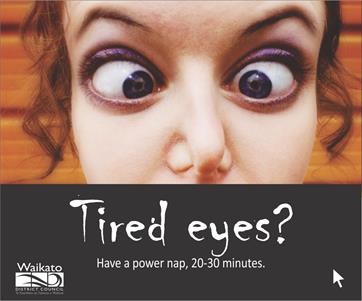People often think that driver fatigue means falling asleep at the wheel. Falling asleep, however, is an extreme form of fatigue.
Fatigue is tiredness, weariness or exhaustion.
You can be fatigued enough for it to impair your driving long before you ‘nod off’ at the wheel.
For example, when you are fatigued:
- your reactions are much slower
- your ability to concentrate is reduced
- it takes longer to interpret and understand the traffic situation.
Why is fatigue a problem?
The most common effects of fatigue on driving are:
- difficulty keeping your car within a lane
- drifting off the road
- more frequent and unnecessary changes in speed
- not reacting in time to avoid a dangerous situation.
These effects lead to a high number of single vehicle crashes involving a car striking a tree or other rigid object, and severe head-on collisions.
Driver fatigue is difficult to identify or recognise as contributing to a crash. This means it’s likely that fatigue is under-recorded, and contributes to more crashes than we realise.
Fatigue needs to be taken very seriously.
What causes fatigue?
Sleep loss
Loss of sleep is one of the main, and most commonly known, causes of fatigue. Everyone has a basic sleep need. This can vary from person to person, but the average is seven to eight hours a day. If you don't get a full night's sleep, you're likely to be fatigued the following day. As little as two hours sleep loss on one occasion can affect reaction time, mental functioning, memory, mood and alertness.
Several nights of restricted sleep leads to a sleep debt. If you allow a sleep debt to get too large, the brain will eventually go to sleep involuntarily (micro-sleep), even if this puts you at risk. Micro-sleeps generally only last a brief period, but can be very dangerous if they happen while you're driving. For example, if a driver has a micro-sleep for just one second while travelling at a speed of 100km/h, the car will have gone 28 metres without a driver in control.
Circadian rhythms
We have an in-built body clock in the brain, coordinating daily cycles known as circadian rhythms. The clock programmes us to feel very sleepy between 3am and 5am, and to experience a secondary peak in sleepiness between 3pm and 5pm. At these times, you'll experience your worst physical and mental performance of the day. There's an increase in fatigue-related crashes at these times.
Time spent on a driving 'task’
Studies that have looked at driving' tasks' show that the length of time spent on a task affects the quality of performance. As more time is spent on a task the level of fatigue increases, the time to react is slowed, attention and judgement are reduced, and the chances of falling asleep during the task are increased.
Who is affected?
While all drivers are likely to experience fatigue to some degree, fatigue is more likely for people in the following groups – ultimately leading to a higher crash risk:
Young people – many young people have lifestyles that involve frequent late night activities, not getting enough sleep, taking risks and being on the roads during night time hours.
Shift workers – shift workers are more likely to have disrupted sleep patterns, which lead to fatigue. Night shift workers have the greatest risk of sleep disruption.
People with sleep disorders – sleep disorders disrupt the quality and quantity of sleep a person gets. The most common disorder is sleep apnoea.
How can I improve my alertness?
Sleep and circadian rhythms
Get plenty of sleep before a long journey. Plan to drive during times of the day when you’re normally awake, and stay overnight rather than travelling straight through. Avoid driving during times when we’re programmed to be sleepy. Take a mid-afternoon break and find a place to sleep between midnight and 6am.
Take breaks and have a nap
Schedule a break at least once every two hours, and whenever you begin to feel sleepy. During a break get out of your vehicle and have a walk, or some form of exercise, to increase alertness. If you’re feeling sleepy, have a nap. If you realise you need a nap, don’t wait. Find the first safe place and pull over. Try to avoid napping in the driver’s seat, and try not to nap for longer than 40 minutes.

Naps up to 40 minutes can be very refreshing, but naps longer than 40 minutes can leave you feeling groggy and disoriented for up to 10 to 15 minutes after you wake up. (This is called sleep inertia.)
Food and drink
Eat sensibly throughout the journey, but avoid large meals. They can make you drowsy, particularly at lunchtime. Stay hydrated. Caffeine drinks (tea, coffee and cola drinks) help you stay alert, but they take time to be effective. Research has shown that drinking a caffeinated drink, followed by a 20 minute nap, improves alertness in the short term.
Get fresh air into the vehicle
You’ll find it easier to stay alert if you have fresh air blowinginto your vehicle. On long journeys it’s best if you don’t use the recirculating air function.
Share the driving
If possible, share the driving. Environmental stimulation, conversation and music can help you stay alert, but they’re only short-term solutions. The best solution is finding somewhere to stop and sleep.
Avoid medications that make you drowsy
Avoid taking medications, both prescribed and over-the-counter, that lead to drowsiness. Examples of medications to avoid are some antihistamines, travel sickness tablets, sleeping pills, some cold preparations and some pain killers. Always read the packaging of your medications before you drive, to make sure they won’t affect your alertness. If you’re unsure, ask your pharmacist.
Fatigue and commercial driving
Fatigue is taken very seriously in the commercial vehicle industry. Most drivers of commercial vehicles are required by law to fill out logbooks about the hours they drive and the breaks they take. The logbooks are used to assess whether the drivers are following the driving hours regulations.